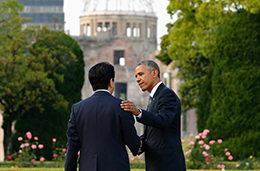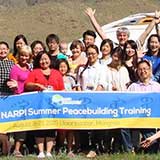
|
 |
|
|
Dear Friends and Supporters of Article 9,
We are pleased to send you our quarterly eNewsletter with some information about the latest developments in the debate over Article 9 in Japan, as well as some of the Global Article 9 Campaign recent activities.
|
|
|
NEWS FROM JAPAN - WILL THE OUTCOME OF ELECTIONS SET THE STAGE FOR CONSTITUTION AMENDMENT?
 Japan’s ruling coalition scored a hefty victory in the July 10 nationwide election for the Parliament’s Upper House, where half of the 242
Japan’s ruling coalition scored a hefty victory in the July 10 nationwide election for the Parliament’s Upper House, where half of the 242 seats were up for grabs. Japan’s ruling coalition scored a hefty victory in the July 10 nationwide election for the Parliament’s Upper House, where half of the 242
Japan’s ruling coalition scored a hefty victory in the July 10 nationwide election for the Parliament’s Upper House, where half of the 242 seats were up for grabs.
While a shift of power balance was never in question, the real issue was whether Prime Minister Abe Shinzo would be able to bolster his majority, and if so, by how much. Abe’s Liberal Democratic Party has ruled in Japan almost without interruption since the end of World War II.
Abenomics or Not
Prime Minister Abe Shinzo campaigned for the election on his economic agenda, known as Abenomics, repeatedly emphasizing economy as the foremost issue. Although Abe has acknowledged his failure to revive the economy thus far, he has claimed that “the only choice is to go forward.” He has, however, failed to specifically explain how he will achieve this.
The opposition, media and observers have accused Abe of attempting to divert attention from his real plans, as he also did in 2012. That is, of his long-held goal of revising the Constitution, especially the war-renouncing Article 9, to lift constitutional constraints on Japan’s military.
Coalition’s Clear Majority
Abe’s strategy proved successful. The LDP-Komeito ruling coalition won a combined 70 seats, with 56 and 14 new seats respectively – exceeding the self-imposed target of 61 seats. Combined with other minor conservative parties such as Initiatives from Osaka and the Party for Japanese Kokoro, pro-constitutional amendment parties now hold a total of 161 seats – just one seat short of the 162 threshold for the two-third majority required to initiate a constitutional referendum. However, according to the Asahi Shimbun, some additional independent lawmakers favor constitutional revision, thus paving the way for the needed supermajority. The ruling coalition already has a supermajority in the more powerful Lower House.
In a television interview in the evening of July 10, Abe rejoiced that he now has a mandate from the public for his economic policy. “We were given approval for our mandate to powerfully pursue Abenomics. We’d like to continue with our efforts to achieve what we’ve promised,” he said.
On June 27, NHK announced that according to its recent survey only 6 % of those polled thought the Abenomics was working well. Another study conducted by the Asahi Shimbun indicated a mere 28% of voters want Abenomics “pursued further.” But amidst post-Brexit financial turmoil, voters chose what they saw as stability. According to the New York Times, the election results “reflect resignation with the status quo rather than a broad mandate.”
Opposition’s failure to offer an alternative
Meanwhile, opposition parties failed to increase their representation, as they had hoped.
During the campaign, the Democratic Party, Japanese Communist Party and others decided to unite behind single candidates in all 32 contested single-member electoral districts to maximize their chance.
Opposition parties saw this election as an opportunity to pass a comprehensive judgment on what the current administration has done over the last 3½ years, warning voters not to get distracted from the issue of constitutional reform, since at the end of the day, the outcome of the election could set the stage for amending the Constitution.
Yet, the message failed to mobilize voters. The Democratic Party ended up 11 seats weaker than before the election (with 49 seats), while the Japanese Communist Party and Initiatives from Osaka did not manage to increase their seat counts.
The Democratic Party, which led the government from 2009-2012, still suffers from a lack of trust after its inability to deliver on his promises, and has since failed to be pictured as a credible alternative to the LDP. During the campaign, it was seen as failing to make concrete and viable counter-proposals to Abe’s economic and welfare agenda.
Constitution as a Campaign “non-“ issue
Throughout the campaign, Abe made significant efforts to downplay constitutional revision as an election issue. In fact, he barely mentioned it. This strategy stems from the fact that it is a clear point of contention for the Japanese public, as well as among coalition and opposition parties. In fact, even parties that favor constitutional amendment have not reached an agreement on what should be subject to revision and how it should be revised.
Yet, in January 2016, Abe announced he wanted his coalition to win a two-thirds majority in the Upper House election to enable him to revise the constitution. He has also repeatedly made it clear that he wants to revise the Constitution while he is in office.
But during the campaign, he changed tone and said: “I believe it is difficult under the current circumstances to revise Article 9." Most recently, in a television interview, LDP Vice President Komura Masahiko went as far as claiming “there is zero possibility” that Abe would try to revise Article 9 even with a two-thirds majority.
However, as polls closed, several figures of the Liberal Democratic Party made clear their intention to take on the issue. Among them, LDP’s policy chief Inada Tomomi reminded: “Our party is one that calls for reforming the Constitution…… [and] has already submitted a draft for reforming the Constitution.” LDP Vice President Komura, for his part, suggested the Diet should start deliberating and decide which clauses should be revised.
As for Prime Minister Abe, he declared: “To realize a revision of the constitution is my duty as LDP president.” He further highlighted the fact that “the LDP has held the goal of revising the Constitution since its formation and it included that goal in its platform for governing”.
“I hope the debate will deepen steadily from now," Abe added, further indicating his intention to have constitutional commissions in both chambers of the Diet begin discussions this fall during an extraordinary session of the Diet to “initiate, develop and narrow down” which specific articles should be changed, and in what way.
Will Abe now go ahead?
The outcome of the elections may have opened a window of opportunity for the pro-amendment political forces to consider moving forward. It does not mean, however, that amending the Constitution has now become imminent.
For one thing, according to a Kyodo poll held in June, only 11.7% of all candidates think constitutional revision is a priority. Furthermore, even parties that generally favor constitutional amendment have not reached an agreement on what parts of the constitution should be altered, where to start and how it should be revised. To date, except for the 2012 LDP’s draft amendment, there are no specific proposals on the table.
No public support for the “Abe Doctrine”
Most importantly, despite the ruling coalition’s strong grip in the Diet’s Lower and Upper Houses, revising the Constitution remains unpopular. Revision requires not only supermajorities in both chambers; any constitutional amendment also needs to be approved by a majority of voters. Yet, the administration is far from being able to count on that. According to a Mainichi newspaper poll carried out in June, 45% of respondents oppose revision, against 36% in favor.
However, although constitutional amendment does not seem imminent, never has the prospect of revising the constitution been as real as it is today.
Prime Minister Abe has already misled voters about his intentions in the past, and proven that he is able to push forward his conservative agenda, even when he has not been given a popular mandate for the same.
It is regrettable that the massive demonstrations and polls indicating majority opposition to his constitutional plans did not materialize into votes. We can only hope that Japanese citizens will remain alert and mobilize to protect the country’s pacifist norms and democratic values.
Picture credit: Toru Hanai, Reuters
|
OBAMA'S HISTORIC VISIT IN HIROSHIMA - READING BEYOND THE RHETORIC
 On May 27, 2016, Barack Obama became the first ever sitting United States president to visit Hiroshima, one of the two cities destroyed 71 years ago by US atomic bombs. On May 27, 2016, Barack Obama became the first ever sitting United States president to visit Hiroshima, one of the two cities destroyed 71 years ago by US atomic bombs.
The historic visit was meticulously planned in Tokyo and Washington in what observers qualify as a “diplomatic dance”. The highly symbolic visit had to appear as the continuation of his “vision for a nuclear-free world,” yet without seeming to apologize or to re-open the controversy over the legitimacy and necessity of the bombings of Hiroshima and Nagasaki; to highlight the Japan-US strategic partnership, yet without drawing the ire of Japan’s neighbors that feared the visit would be used to condone Japan’s attempts to whitewash its responsibility for wartime atrocities. For nuclear disarmament advocates, the hope was that his visit would draw attention to the catastrophic human cost of atomic weapons.
Like the protocol for the ceremony, Obama’s 17-minute speech was reworked many times, to make it “a broad reflection on what we must learn from history.” According to his speechwriter, his statement had to be “profoundly realist” and “idealistic”, while addressing several key issues on the international agenda. Japanese Prime Minister Abe Shinzo, who accompanied President Obama, also made a statement. In their addresses, the two leaders spoke of nuclear disarmament, reflected on war in general, and showcased the US-Japan alliance.
Yet, beyond the rhetoric, what have the two leaders accomplished on peace, security and nuclear disarmament?
>NUCLEAR DISARMAMENT
The visit was undeniably meant as the symbolic culmination of Obama’s nuclear policy since he laid out his vision for a nuclear weapon free world in his 2009Nobel Peace Prize-winning speech in Prague in 2009. Yet, seven years later at the Hiroshima Peace Memorial Park, his tone and commitments were not as convincing: he did not announce any concrete policies or steps for nuclear disarmament.
Moreover, his record in this area cannot be matched by actual progress. Indeed, despite his call for a nuclear weapon free world, Obama’s administration has since he took office reduced US stockpiles less than any other post-Cold War administration; signed off on a $1 trillion modernization program of the US nuclear arsenal over the next three decades – the largest in US history; and refused to participate in (and even attempted to stall) all recent multilateral efforts aimed at taking forward nuclear disarmament, most notably the current momentum towards starting negotiations on a new international treaty banning nuclear weapons, potentially set to begin as early as next year.
Asai Motofumi, a former Japanese Foreign Ministry official who directed the Hiroshima Peace Institute from 2005 to 2011 commented on the visit: "Obama has not come up with positive policies to reduce nuclear weapons let alone dismantle nuclear weapons in the seven years after he delivered a speech in Prague in 2009."
Likewise, Japan – which pictures itself as a major voice for a world without nuclear weapons despite its policy of relying on US nuclear deterrence – also has a bleak record in this area.
In recent months, the Abe administration has resisted efforts in international fora, notably by abstaining from the U.N. General Assembly vote to launch a working group to take forward multilateral efforts on nuclear disarmament, taking a negative stance on the Humanitarian Pledge endorsed by 127 states to “prohibit and eliminate nuclear weapons in light of their unacceptable humanitarian consequences and associated risks”, and most recently by opposing a proposal to begin negotiations on a treaty banning nuclear weapons.
Most strikingly, in a blatant negation of Japan’s longstanding Three Non-Nuclear Principles (which forbid it from developing, possessing or introducing nuclear weapons onto Japanese soil), Abe’s Cabinet has claimed that possessing nuclear weapons would not violate the country’s constitution, arguing that “Even if it involves nuclear weapons, the Constitution does not necessarily ban the possession of them as long as they are restricted to such a minimum necessary level.”
OBAMA’S REFLECTIONS ON WAR
More generally, Obama’s speech reflected on World War II and on the brutal nature of war in general: on the suffering it inflicts mostly on innocent people, on the rationale used to “justify violence in the name of some higher cause”, on the need for a moral revolution, on “what we must do differently to curb such suffering again.”
Yet, these considerations left observers skeptical, coming from the president of the country that has the largest arsenal and military capacity in the world and that is involved in many wars around the globe. Indeed, it can be little argued that Obama’s Hiroshima speech will bring a decisive change to US foreign policy, let alone to the US nuclear doctrine.
As he reflected on the brutal nature of war and asked “what we must do differently to curb such suffering again”, President Obama made no reference to Japan’s peace constitution, nor to the current debate to amend its war-renouncing clause, Article 9.
Japan’s Constitution, drafted and adopted after WWII, renounces war as a means of settling international disputes. For over 70 years, the values of peace embodied in the Constitution have inspired Japan’s policies, such as its exclusively defense-oriented security strategy, its general ban on arms export and its non-nuclear principles. Article 9 not only made Japan what it is today. It has also played an important role in establishing trust relationships between Japan, the people of the Asia-Pacific, and the international community.
In his Hiroshima speech, Obama said: “We’re not bound by genetic code to repeat the mistakes of the past. We can learn. We can choose. We can tell our children a different story, one that describes a common humanity, one that makes war less likely and cruelty less easily accepted.” This is precisely what Japan’s war-renouncing Article 9 has meant for generations of Japanese, Northeast Asians and beyond. A legacy of the Second World War, Japan’s peace constitution has indeed been acting as a peace mechanism in the region.
However, over recent years, the Abe administration has led a long series of attacks on Japan’s peace principles, notably by reinterpreting the Constitution to allow Japan to exercise the right to collective self-defense and to expand Japan’s security role around the world.
In fact, the US has been welcoming – and some will even say pushing for – these revisions, to allow Japan “to significantly increase its contribution to regional and global security and expand its role on the world stage” and “make the US-Japan alliance even more effective.”
SHOWCASING A STRONG US-JAPAN ALLIANCE
Japan’s efforts to amend its peace constitution and the related US position must be understood in the broader context of the two countries’ efforts to bolster their alliance as part of the US “Pivot to Asia” – an attempt to deepen US diplomatic, economic and military ties in the region in order to contain China.
As such, the joint Obama-Abe visit to Hiroshima was undeniably meant to showcase the strengthening of the U.S.-Japan alliance. Prime Minister Abe, in particular, highlighted the “trust and friendship” between the two countries, and qualified the relationship as “an alliance of hope for the world”. He went on, repeating that “Japan and the United States will together become a ‘light to bring hope’ to the people in the world.” For his part, Obama seemed to be a little more careful in the way he portrayed the alliance. According to some observers, a slight difference of tone could be noticed between the two leaders. By emphasizing the “friendship that has won far more for our people than we could ever claim through war,” Obama may have intended to focus more on the reconciliatory role of the alliance.
Yet, although neither mentioned China explicitly, the boasting of a strengthened alliance between the two countries was evidently meant to send a strong signal to China, as tensions are rising in East Asia, particularly in and around the South China Sea.
Indeed, Washington has over recent months been strengthening security agreements with countries in the region, including not only Japan, but also the Philippines, Vietnam, Malaysia, Cambodia and Bangladesh. Just a few days before he arrived in Hiroshima, US President Obama visited Vietnam, where he lifted a 50-year long weapons sales embargo.
In fact, as he spoke of “avoid[ing] war“, “prevent[ing] conflict through diplomacy” and “ma[king] choices that give us hope”, US ships and fighter jets were maneuvering across the South China Sea.
ACTIONS SPEAK LOUDER THAN WORDS
All these actions truly undermine the meaning of Obama’s words, and make it hard for anyone to believe in his call to reinvent a “story -- …. one that makes war less likely and cruelty less easily accepted.”
As historic as his visit in Hiroshima was, one cannot move past the disconnect between the strong rhetoric and the policies that actually prevent us from making tangible progress for peace and achieving a nuclear weapon free world.
Read US President Barack Obama’s and Japanese Prime Minister Abe Shinzo’s speeches made on May 27, 2016 in Hiroshima.
Read Peace Boat’s statement about the historic visit here.
Read ICAN’s press release here.
Photo credit: Agence France Presse |
NORTHEAST ASIA - INITIATIVES TOWARDS A PEACEFUL SUSTAINABLE FUTURE
 This summer, two important initiatives will take place in Northeast Asia, as the regional context continues to be increasingly tense. The following projects seek to foster friendship, understanding and build a sustainable peace in the region. This summer, two important initiatives will take place in Northeast Asia, as the regional context continues to be increasingly tense. The following projects seek to foster friendship, understanding and build a sustainable peace in the region.
Peace and Green Boat is a joint project of Peace Boat and Korea's largest environmental NGO, the Green Foundation, which seeks since 2005 to build new bridges between Japan and Korea and a peaceful, sustainable future in the region. This year, Peace & Green Boat 2016 Asian Regional Voyage - the ninth such voyage - will be held from July 29 to August 6, 2016 and visit the ports of Busan, Shanghai, Naha and Nagasaki.
Read more about Peace & Green Boat 2016 here.
Northeast Asia Regional Peacebuilding Institute (NARPI) is an institute to promote peace in the region by creating space for learning peacebuilding and building networks among peace-loving people in Northeast Asia. Every year, NARPI hosts a summer training program that provides a selection of six different courses and field trip. This year, it will take place in Taiwan, from August 7-20. Find out more about this year's NARPI program here.
|
APPLY NOW- PEACE BOAT'S GLOBAL UNIVERSITY ON HUMANITARIAN DISARMAMENT
 Peace Boat is pleased to announce its upcoming Global University program on “Changing the Approach: Humanitarian Disarmament, International Law and the UN” that will be held from October 4-21, 2016 as the ship sails between The Hague, The Netherlands, Reykjavik, Iceland and New York. Peace Boat is pleased to announce its upcoming Global University program on “Changing the Approach: Humanitarian Disarmament, International Law and the UN” that will be held from October 4-21, 2016 as the ship sails between The Hague, The Netherlands, Reykjavik, Iceland and New York.
Global University is a peace education program that takes place at sea during Peace Boat's Global Voyages and offers a unique curriculum that combines "exposure" programs (field visits) in ports with workshops and seminars onboard to address a range of global issues, including peace, human rights, and the environment.
During this 18-day program, participants will learn about the humanitarian impact of nuclear and other weapons, analyze various disarmament initiatives, hear directly from and interact with survivors, as well as exchanges ideas and perspective with educators, practitioners and experts in the field.
Peace Boat welcomes students and young professionals from around the world between the ages of 18 to 35 interested in learning about peace, security, disarmament, international law and international relations.
Last chance to apply: application will close at 17:00 (Japan Standard Time) on Sunday, July 31, 2016.
Download the application form and read more about the program here.
|
REPORT - 2016 GLOBAL DAYS OF ACTIONS ON MILITARY SPENDING A SUCCESS
 The Global Days of Action on Military Spending (GDAMS) are part of the Global Campaign on Military Spending, led by the International Peace Bureau (IPB), which denounces the excessive military expenditure of governments around the world and calls for the reallocation of resources towards peace and sustainable human development.
The Global Days of Action on Military Spending (GDAMS) are part of the Global Campaign on Military Spending, led by the International Peace Bureau (IPB), which denounces the excessive military expenditure of governments around the world and calls for the reallocation of resources towards peace and sustainable human development.
Every year since 2011, in April, civil society groups around the world organize events to coincide with the release of the annual world military expenditure figures by the Stockholm International Peace Research Institute (SIPRI).
This year, from April 5th to 18th, 120 GDAMS events took place in 23 countries. These events varied in shape and size depending on countries and partners. As in previous years, a whole range of actions where organized, including : street protests/demonstrations, seminars, press conferences, media releases, videos, petitions, peace vigils and penny polls.
Some of the activities took the form of ‘PrepComms’ for the upcoming IPB World Congress: Disarm! For a Climate of peace that will take place in Berlin on September 30-October 3.
Download GDAMS 2016 final report here.
|
|
|
Thank you for your interest in and support for the Global Article 9 Campaign to Abolish War.
Peace,
The Article 9 Team
|
|
|
|
|
| ©2008
GPPAC JAPAN All Rights Reserved. |
|